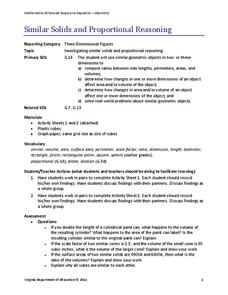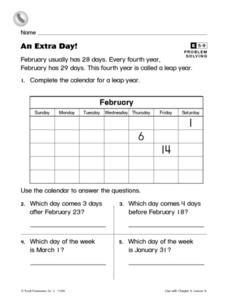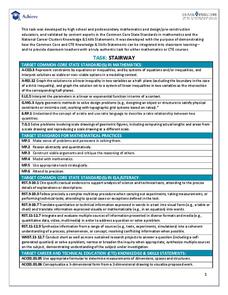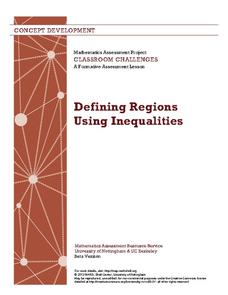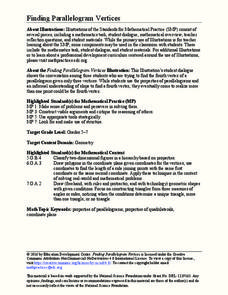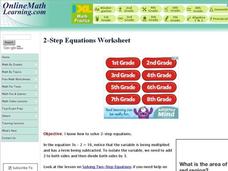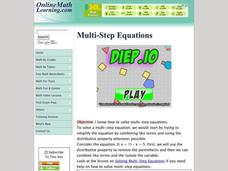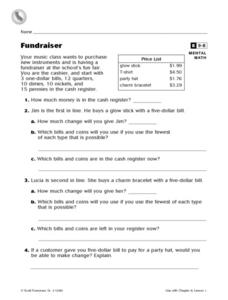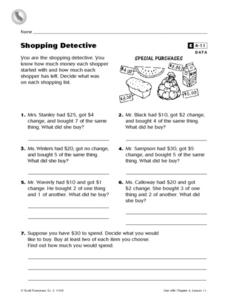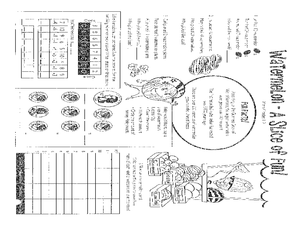National Council of Teachers of Mathematics
Do I Have to Mow the Whole Thing?
In this mowing worksheet, learners find the area of given rectangles. They determine the combinations of lengths and widths that generate a given area. Learners graph given points. This two page worksheet contains sixteen multi-step...
Curated OER
Perimeter, Area, and Volume of a Rectangular Prism
In this prism math lesson, students answer and solve the 10 problem sentences for perimeter, area, and volume of a rectangular prism. Students select their answers from multiple choice options.
Curated OER
Add and Subtract Two-Digit Numbers
Learners complete two double-digit problems, one addition and the other subtraction. They also determine the missing addend in two additional problems. An explanation as to how to solve both problems is included.
Curated OER
Making Ten
Provide learners with both the questions and the answers at the same time. They will consider each problem and then read how to solve it. There are two problems in which they are required to make 10 by completing the steps found in each...
Curated OER
Counting Corners and Sides of Shapes
Kids count shapes, corners, and sides. They locate the corners and sides of each given shape, then count and record them in the space provided. Here you will find a worksheet that provides a step-by-step process for how the problems...
Virginia Department of Education
Similar Solids and Proportional Reasoning
Double the dimensions, quadruple the surface area. Pairs build similar prisms and compare the ratios of their surface areas and volumes to the ratio of the heights. Given two similar cones, partners determine the ratios of the lateral...
Curated OER
An Extra Day!
Leap year is an important concept to understand- give learners some practice with this complete-the-calendar worksheet. The calendar month of February during a leap year is pictured, however it is incomplete. Scholars complete the month...
Curated OER
Finding A Percentage
Helpful after a lesson on percentages, this worksheet can reinforce the steps and formulas necessary for finding percentages. Middle schoolers calculate the percent one number is of another, and then the percent of change (increase or...
Curated OER
Dental Impressions
What an impressive task it is to make dental impressions! Pupils learn how dentists use proportional reasoning, unit conversions, and systems of equations to estimate the materials needed to make stone models of dental impressions....
Achieve
Stairway
It's the stairway to learning! Scholars research all aspects of building a staircase. Using information from building codes, they write and graph a system of inequalities to analyze the constraints. The completed project is a scale model...
Howard County Schools
Setting the Table
How many people can fit around a table? Depends on the size of the table, right? Explore patterns to generate an equation for the number of people that can fit around a table given its size.
Curated OER
Narrow Corridor
Buying a new sofa? Learn how to use the Pythagorean Theorem, as well as algebra and graphing techniques, to determine whether the sofa will fit around a corner (which I'm sure you'll agree is a very important consideration!).
MARS, Shell Center, University of Nottingham
Defining Regions Using Inequalities
Your young graphers will collaboratively play their way to a better understanding of the solution set produced by the combining of inequalities. Cooperation and communication are emphasized by the teacher asking questions to guide the...
University of Utah
Representations of a Line
Line up to learn about lines! Scholars discover how to express patterns as linear functions. The workbook then covers how to graph and write linear equations in slope-intercept form, as well as how to write equations of...
Grammar Net
Numbers 1-30
Jot down some figures with an activity about printing numbers. First, learners fill in the blanks with the numbers next to their printed forms. Then, they complete simple addition and subtraction problems with numbers that are...
Education Development Center
Consecutive Sums
Evaluate patterns of numbers through an engaging task. Scholars work collaboratively to determine a general rule reflecting the sum of consecutive positive integers. Multiple patterns emerge as learners explore different arrangements.
Education Development Center
Proof with Parallelogram Vertices
Geometric figures are perfect to use for proofs. Scholars prove conjectures about whether given points lie on a triangle and about midpoints. They use a provided dialogue among fictional students to frame their responses.
Education Development Center
Finding Parallelogram Vertices
Four is the perfect number—if you're talking about parallelograms. Scholars determine a possible fourth vertex of a parallelogram in the coordinate plane given the coordinates of three vertices. They read a conversation...
Curated OER
2-Step Equations
For this online math worksheet, students solve for "x" by completing simple two-step equations. This excellent resource allows the students to check their answers, and to get "hints" should they run into difficulties. A terrific teaching...
Curated OER
Multi-Step Equations
In this online math learning exercise, high schoolers solve multi-step equations which have the variable on both sides. This excellent resource allows the students to check their answers, and to get "hints" should they run into...
Curated OER
Fun Figures
For this mental math worksheet, students solve 4 problems pertaining to scoring points in a target game. Students compute game scores mentally to answer each story problem.
Curated OER
Fundraiser
In this money problems worksheet, learners solve 4 story problems that pertain to buying merchandise and making change in a booth at a school fair.
Curated OER
Shopping Detective
In this consumer math worksheet, students analyze the prices on 4 food items in a store. Students solve 7 word problems with the information.
Curated OER
Watermelon - A Slice of Fun
In this multiple math skills about watermelons worksheet, students solve most and least word problems, subtract to solve a cod and find the answer to a question, count coins, and graph types of watermelons. Students solve 28 problems.





